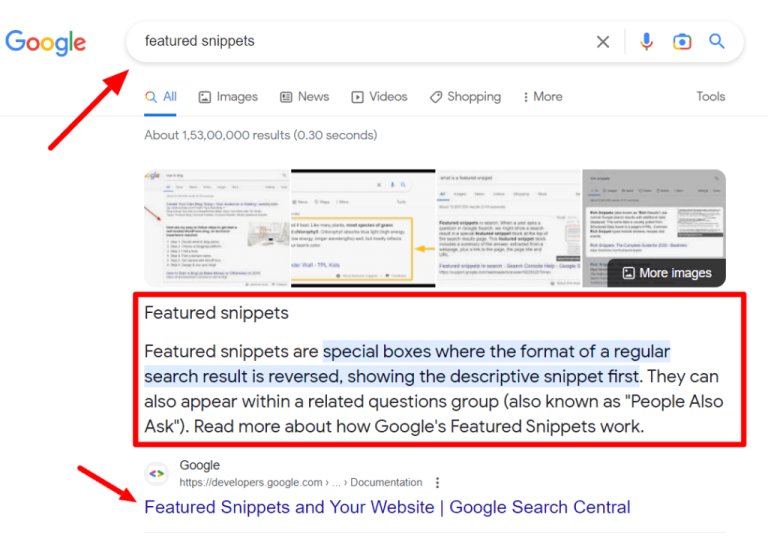
What’s better than being at Position #1 in Google? Being at position #0!
If you want to become Google’s chosen one for a featured snippet, you’ve come to the right place. Getting a featured snippet can be an extremely effective way to increase visibility and boost the authority of your brand or business.
However, is a featured snippet an easy way to the top of the SERPs? It’s a bit complicated. Getting a featured snippet for a query can get you to the top of SERPs, but you’ll have to work to at least the first page of Google. Even then, a featured snippet may not always be the best thing, as we’ll get into.
Let’s break down how to get a featured snippet on Google and what that might mean for your website.
What is a featured snippet?
Featured snippet meaning
Featured snippets are the quick answers Google provides above the first organic result in the SERPs. You’ve likely referenced a featured snippet when searching in the past. The link to the webpage from which the summary is pulled is displayed under the snippet. This is also known as “Position No. 0.”
According to a study by Ahrefs, 99.5% of the time, the snippet or the summary comes from a page that already ranks in the top 10 search results. This is why we said you must work your way to at least the first page before dreaming of a featured snippet.
But fear not! Getting to the first page of Google is very much achievable.
Featured snippet example
There are many types of featured snippets, like short paragraphs, numbered lists, bulleted lists, tables, etc. What remains true across all types is that they’re geared towards providing a user with the most immediate and concise answer to their question.

Above is an example of a featured snippet for the search query “featured snippets.” Below the explanation, you can see the link to the Google support page that this is pulled from.
Featured snippet SEO benefits
This is a tricky one. There are some clear and non-debatable SEO benefits to getting a featured snipped from one of your web pages:
- Increased brand awareness: Getting to position 0 means more visibility, which translates to more brand awareness. According to a Semrush study, featured snippets occupy almost 50% of the screen space for mobile users, meaning you’re getting a lot of real estate for a lot of users.
- Boosting authority: Whenever Google recognizes your content providing a clear answer to a search query, you’ll enjoy an automatic increase in your domain authority, bringing in more targeted traffic to your pages.
You’d think being above position 1 in the SERPs for a keyword would mean optimal traffic, too. Unfortunately, things aren’t so cut and dry with featured snippets when it comes to traffic and click-through rates (CTRs).
For instance, if your webpage answers a query with informational intent, a featured snippet may decrease CTR instead of increasing it! The same Ahrefs study from earlier found that if your web pages are already in the first or second position, getting featured snippets results in decreased CTRs.
On the other hand, if you’re not in the first or second position, getting a featured snippet will definitely mean more traffic because featured snippets get 35.1% of all clicks for a query.
While the effects on CTR may not be clearly defined, the role of featured snippets in increasing brand visibility and authority is undeniable. This is why getting a few under your belt is worth the effort.

How to optimize for featured snippets on your website
Find the featured snippets you might already have
Using a tool like Semrush or Ahrefs, search your website content for keywords that already have featured snippets in the SERPs. Since 99.5% of the featured snippets come from the first page of the SERPs, it’s best to look at your best-ranking content and filter for “featured snippets.”
When you find them, don’t do a thing! We mean it! You don’t want to mess with something that’s already working.
Why should you find featured snippets that you already have, then? Because finding featured snippets in your existing content will lay the groundwork for the following two tips: optimizing your best-ranking content and creating new content.
Leverage your best-ranking content
The most useful asset in getting featured snippets is your best-ranking content, preferably those ranking on page one of Google.
First, you need to see if the query for that content qualifies for a snippet. Simply search up the intended query and see if there’s already a snippet in the SERPs. Once you have a relevant query, filter your pages that are ranking but aren’t generating a snippet. You’ll want to optimize these to steal a competitor’s snippet for yourself.
Here are ways you can do that:
- Evaluate your competitor’s snippet to see how it answers the query.
- Answer the query as clearly as possible in your content.
- Follow the optimal phrasing and length for featured snippets.
- Take pointers from your existing snippets.
Search intent is paramount, which is why snippets are almost always informational. Keep this in mind as you parse through your content.
Prioritize low keyword difficulty and high audience relevance
To have a better chance at securing a featured snippet, you’ll want the focus keyword to be as specific as possible. In other words, prioritize long-tail keywords. These kinds of keywords aren’t difficult to rank for and are very relevant to searchers.
Long-tail keywords should ideally be a part of your larger keyword research strategy, as they bring the most targeted results. When creating new content, keep these best practices in mind:
- Focus on answering the question, using the inverted pyramid method.
- Make content 1,100 words or more (best performing for a featured snippet).
- Use the most effective format to answer the question (paragraph, list, etc.).
- Use heading tags to structure your content and alt tags for images.
- Use keywords in your titles, headings, meta description, and body text.
Also, use schema markup where appropriate. This is good practice for all kinds of website content now because even if you don’t get a featured snippet, you might end up with a rich snippet. Check how your current schema markup is performing with Google’s Rich Results Test.
In short, follow on-page SEO best practices to make content recognizable, follow off-page SEO tactics to get the first page, and ensure your page is optimized for a featured snippet.
Build authority with consistent content
At times, your page is the most optimized for the search query as it can be, but you still haven’t secured a featured snippet. In this case, you may just need to rank better and build your brand authority. It’s a lot easier to get snippets when you’re on the first page of SERPs.
If this is where you’re at, the best thing you can do is focus on creating regular, helpful content until you’ve built enough clout with Google. Where most businesses fail here is consistently generating valuable content that nails all the best SEO practices and principles.
Want to become a content machine? Find experts who can create amazing content for you! That’s what we do at Ranq. We provide our clients with engaging, valuable content that drives targeted traffic and builds your authority. The best part? All content follows the latest SEO insights.
Check out what we’ve done for our clients!
Need more tips to get a featured snippet? Contact Ranq today!
In summary, the three pillars of getting a featured snippet are:
- Answer the query as clearly as possible using the best format.
- Ensure you meet on-page SEO standards to help Google read pages.
- Build authority with valuable content to rank on the first page of Google.
If you need help with any of these, Ranq is here to save the day! We build complete SEO marketing strategies from the ground up, including tactical content creation that feeds your content machine. Contact us today to see how we can meet your goals!
